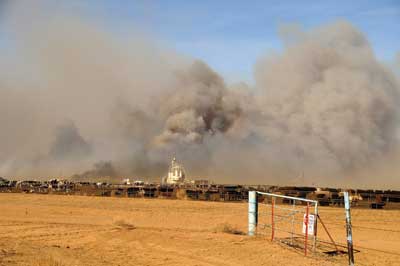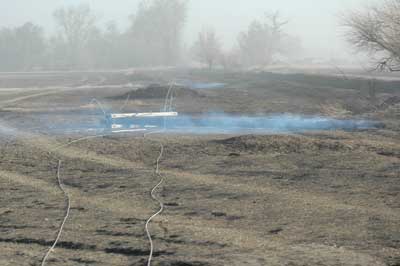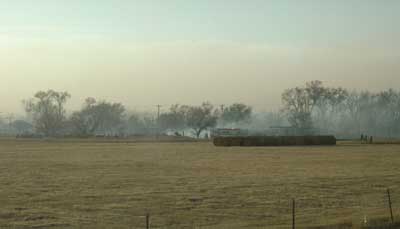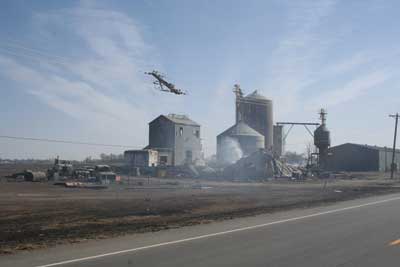BY RICHARD GRAEBER
Every year we watch in awe as hundreds and thousands of acres of the Intermountain West and the West Coast; timbered hillsides; brush-covered slopes; and, unfortunately, home after home are gobbled up by flamefronts of fire pushed by strong easterly winds. These fires dominate local and national news for days on end; hundreds of engines and aircraft and thousands of personnel are assigned to battle these fires. At some point, we win, Mother Nature relents, or a combination of both occurs and the inferno goes out.
 |
| (1) Fire approaches a cattle stockyard. [Photos courtesy of Larry Reeves, Crowley County (CO) Office of Emergency Management.] |
What about the events we don’t hear about that happen around the country throughout the year that involve those small fires, an acre—maybe 10 acres—in size, that consume a home or two or burn a few thousand acres of agricultural land and bump into small-town USA with limited fire forces?
By comparison and to scale, these events are just as serious, placing overwhelming demands on the local and regional communities they affect. However, it is paramount that the local emergency response community plans, prepares, establishes a rock solid command structure (incident command system), develops evacuation plans, and clearly defines the roles and responsibilities of its members for these events.
RECOGNIZING THE POTENTIAL
Before any of the planning, preparation, and response equations can be completed, local emergency responders must first recognize and understand that the potential for a wildfire event is real and can happen. You do not need the hills, mountains, and vegetation of the West; you need an ignition source in the right (wrong) place with the right fuel and weather conditions. Add a couple of homes to the mix, and you may have a small-scale disaster on your hands. Failure to recognize and admit to the potential will have your organization—and, more importantly, your community—playing catch-up when such an event occurs.
PLANNING AND PREPARATION
As with any of our many emergency functions, our success lies in planning. We prepare and train for structural fires, mass-casualty events, and hazardous materials spills and releases, so one would reasonably assume that we have planned and prepared for a wildfire.
 |
| (2) Power and phone lines were destroyed during the fire. What is your power backup plan? |
Let’s take this a step further and add public and community education. Most fire agencies engage in some form of public education. For communities that have identified that they are at risk for an out-of-control wildfire, including those in the flat grasslands and agricultural lands, prevention, education, and preparation are equally important in those locales as in the Western states. It may be even more important, since firefighting resources tend to be scarce and it likely will take more time to acquire them.
TRAINING
Does your agency own any fire apparatus that is specifically designed or designated to fight vegetation fires? If so, your personnel should be trained to a basic level of wildland firefighting. You would not send your people to engage in a structural fire, conduct vehicle extrication, provide emergency medical aid, or respond to a hazardous materials situation without some level of training. Why would you assign personnel to fight a wildfire without proper training?
 |
| (3) Wildfires on agricultural and flat grasslands are a threat to many small communities. |
There is a long list of courses available through the National Wildfire Coordinating Group (NWCG) that, when delivered by a “competent” instructor, can give your people the skills that will prepare them to properly deal with an evolving wildfire situation. More importantly, this training will enable crews to recognize potentially dangerous places or situations because of topographical features or changing weather.
RESOURCES AND REFLEX TIME
We recently hosted an Interagency S-215 class, “Operations in the Urban Interface Program.” I asked the group this question: In the event of a significant wildfire situation, how many engines could you call and have on scene in the first hour? I was somewhat shocked at the wide range of answers. The right answer for us is 10 to 15, depending on other in-progress calls. From that point, we are going out of county, out of region, and likely out of state if control efforts are not successful.
 |
| (4) Local businesses and places of employment destroyed during a fire can cause an extreme economic impact on the community. |
Like structural fires, automatic-aid, mutual-aid, or special-call protocols should be in place and used, especially during times when fire can spread rapidly and quickly involve homes or other buildings. Do not discount large commercial buildings or agricultural structures in your rural-agricultural areas. They have the potential to become high-dollar-loss situations, and in many small communities they may be one of the primary employers for the area.
We must apply reflex time principles to outside resources and know that it will take time for apparatus and personnel to receive notification, arrive at their respective stations, and then respond. In many cases, these resources are other volunteer organizations, and they will likely have extended response times and minimal people.
Rule No. 1: Call early, or it may be too late by the time they arrive.
TRIAGE AND TACTICS
If your agency responds to vegetation fires, you own apparatus designed to combat vegetation fires. Would it not be a reasonable expectation that your training would include some basic tactical considerations specific to vegetation fires? If not, why not? A serious wildfire is a rare event; these rare events (low frequency) have the potential to catch us off guard simply because we do not recognize the potential (high risk).
The NWCG Fireline Handbook references four common denominators of fire behavior on fatal and near-fatal fires: These fires often occur
- On relatively small fires or deceptively quiet areas of large fires.
- In relatively light fuels, such as grass herbs and light brush.
- When there is an unexpected shift in wind direction or in wind speed.
- When fire responds to topographic conditions and runs uphill.
How many of these conditions are applicable to rural agricultural land? A basic understanding of fire behavior, fire weather, topographic influences, and fuel characteristics is essential for applying proper tactics to the event.
Now, let’s complicate the event. The fire is going to impact several populated areas; homes and businesses will ultimately be hit by fire. How do you “sort” them out and protect them from this fire? Battalion Chief (Ret.) J.P. Harris, Los Angeles County (CA) Fire Department, redefined structural triage. These new and improved triage methods were published in February 2010 and are now part of the NWCG 2010 Incident Response Pocket Guide. In the new and improved matrix, LCES (lookouts, communication, escape routes, and safe zones) for personnel and apparatus are the first priority. Once LCES is in place, or not, a fire behavior prediction is necessary. It should include the big three: fuel, weather, and topography and several subconditions under each of those categories. From this point, structures can be placed in four categories:
- Defensible. LCES is available: Prep and Hold. Fire Agency Staffed.
- Defensible. LCES is available: Stand Alone. Not Likely to Ignite. Patrol Status.
- Nondefensible. LCES not available: Prep and Leave. Rapid Light Mitigation.
- Rescue Drive-by. LCES not available. Make sure no one is home if safe to do so.
Each of these categories has well-defined criteria and considerations and should be included as an extended topic of study. We must also remember that preincident preparation is the responsibility of homeowners. Fire agencies should make the effort to educate the public on the need to maintain clearances appropriate to the topography and vegetation around their homes.
EVACUATION
One of the most difficult challenges for an incident commander will be to make the decision to evacuate homes and move people to a shelter. It is a call that will take some courage; however, it should be well thought out and be a joint (unified) decision. I am not talking about evacuating those immediately in harm’s way. I am talking about those who have a couple of hours, half a day, or even longer.
In most places, the term “mandatory evacuation” is nothing more than a very strong recommendation. It is an absolute must that you understand the laws applicable to evacuation in your state.
During a wildfire situation, those engaged in the firefight should do just that, fight the fire. Evacuation should be left to local law enforcement and allied agencies. Fire agencies are certainly a stakeholder in the decision process and will be required to provide some very important input—for example, how fast is the fire spreading, and how long before it impacts populated areas?
Fire ICs must apply reflex time to law enforcement allies as well. Again, we are talking rural areas: How long will it take to assemble five to six deputies to assist in an evacuation—30 minutes, an hour, longer? Are state police available? Does your county have an emergency management official? Do these personnel have protective clothing? The day the fire is burning is not the time to try and figure this out, nor should it be the first time you ever spoke about this topic.
Getting people back home is a completely different dynamic and will require a unified decision-making process that involves fire agencies, law enforcement, the road department, and utility suppliers. The area being repopulated has to be rendered safe and secure. This would be the time to establish a repopulation group focused on getting people back in the areas affected by the fire. This may simply involve letting them see if their homes survived, with proper escorts. Be prepared for a very emotional experience.
In the name of planning and preparation, what medium will be used to notify those threatened by an advancing wildfire—Reverse 911, local television or radio stations, door to door? Door to door is very time consuming and resource intensive. In rural areas, media outlets may not have the coverage found in large population centers, and Reverse 911 may not be an available option in a rural dispatch center, not to mention that phone and power lines may have been damaged as a result of the fire. What is the backup plan?
ROLES AND RESPONSIBILITIES
Roles and responsibilities should not be made up or defined and decided after ignition has occurred. In many cases, there are statutory definitions of who is responsible for what functions. It is imperative that any agency that could be involved in your incident be at the table for discussions that include these defined roles, which resources they have or can acquire, and how long it will take to mobilize those resources.
During these discussions, do not leave out the logistical support function. Nothing will doom an incident faster than one that falls behind in supplying crews with everything from food and drinking water to fuel. In small communities that typically have one or two restaurants, can the restaurants suddenly supply 100 meals?
Knowing the proper notification process is imperative should an incident grow to the size and complexity that will require state and federal resources and financial support—whom to call and who should track resources and incident costs. Failure in any step along the way will complicate efforts to get outside aid and reimbursement.
INCIDENT COMMAND
There is no substitute for a well-managed emergency situation. It is “the” tool to effectively manage resources and make well-thought-out joint (unified) decisions. There is really no excuse not to have some level of incident command training imbedded into the operations of any fire organization. The training is readily available, in most cases at no charge, and it is accessible online. Online programs are a great training aid but do not substitute for a real-time exercise.
A number of functional positions likely will be needed during a significant event. Who will handle your public information duties? With multiple agencies involved, a liaison officer could prove to be invaluable. Include your allied agencies in the conversation, training, and simulations. It will only aid you in the course of managing the incident.
The safety and well-being of your firefighters and your community rest with the decisions you as an IC make early in the incident. It is imperative that you recognize the potential for a serious incident involving wildfire and homes. It takes only a few acres of vegetation to cause significant damage to several homes, which would likely be the most serious event in your small community.
Preincident preparation is the key to success. Train, train, train. There is no substitute for training. If you expect your people to perform in a safe manner and bring an incident to a successful conclusion, they must be trained to a competent level. Complacency will ultimately catch up with you, frequently with tragic results.
Acknowledgments
John (JP) Harris. Structural Triage Matrix. Jpharris1@sbcglobal.net.
National Wildfire Coordinating Group, 2010 Incident Response Pocket Guide.
RICHARD GRAEBER is chief of the Upper Pine Fire Protection District in Bayfield, Colorado. He has an associate degree in fire science and is a certified fire officer. He is a National Wildfire Coordinating Group division supervisor and participates on the Durango Zone Interagency Type 3 Team.

